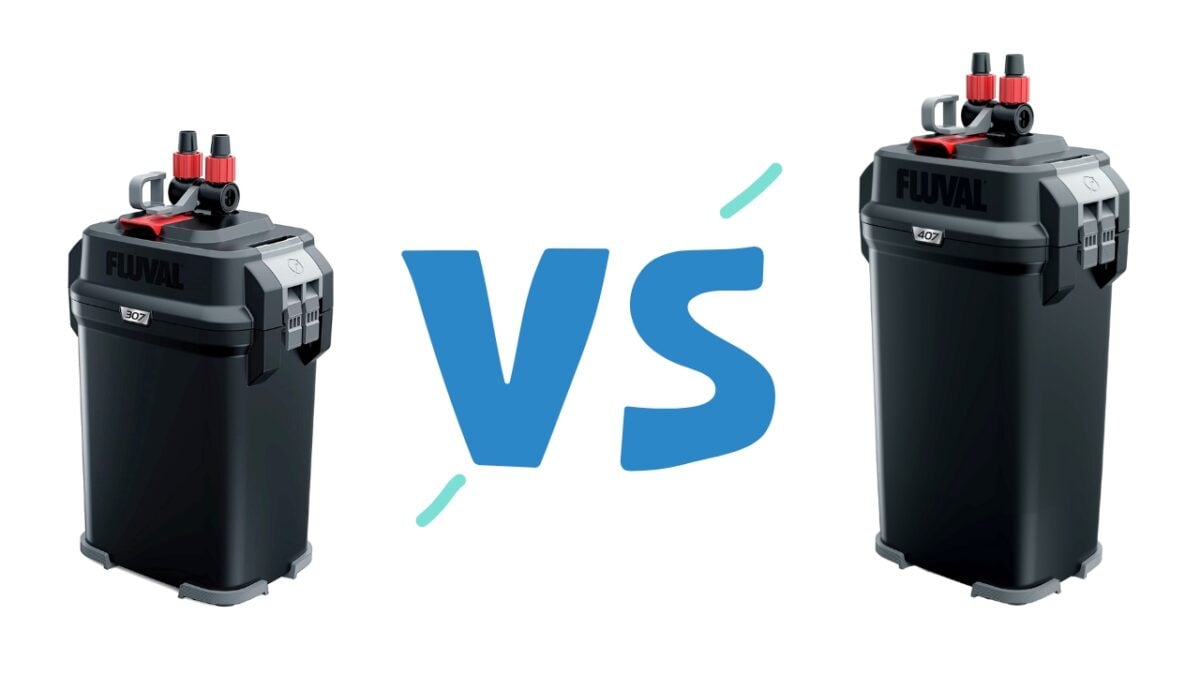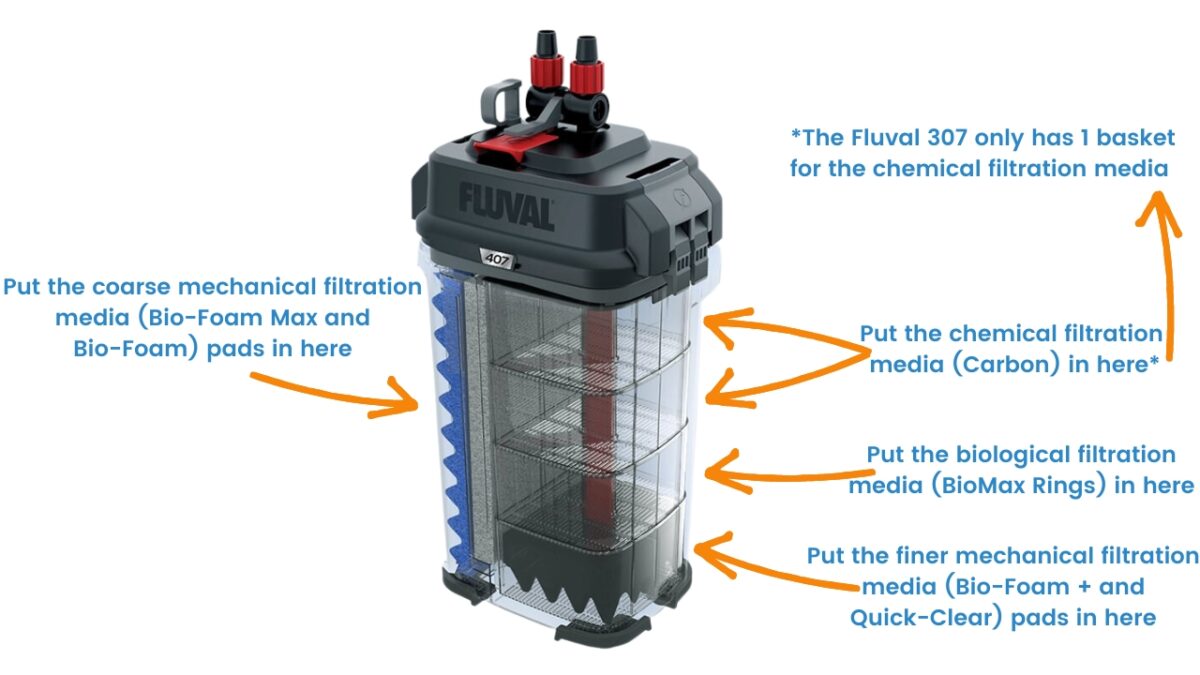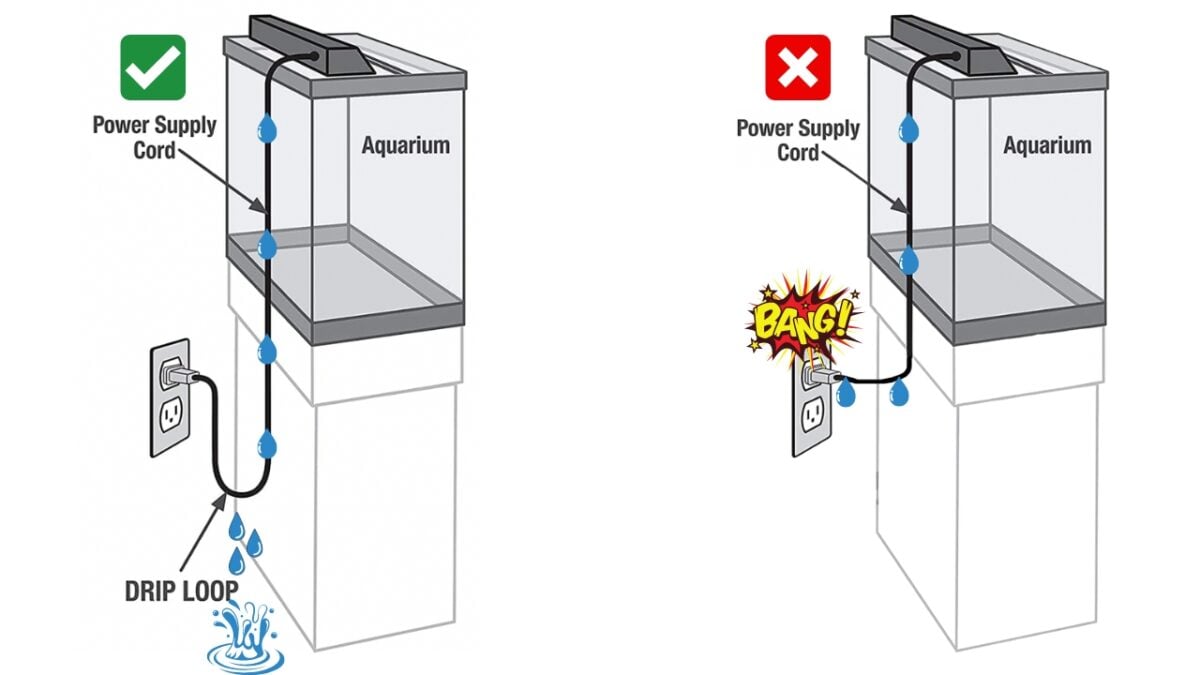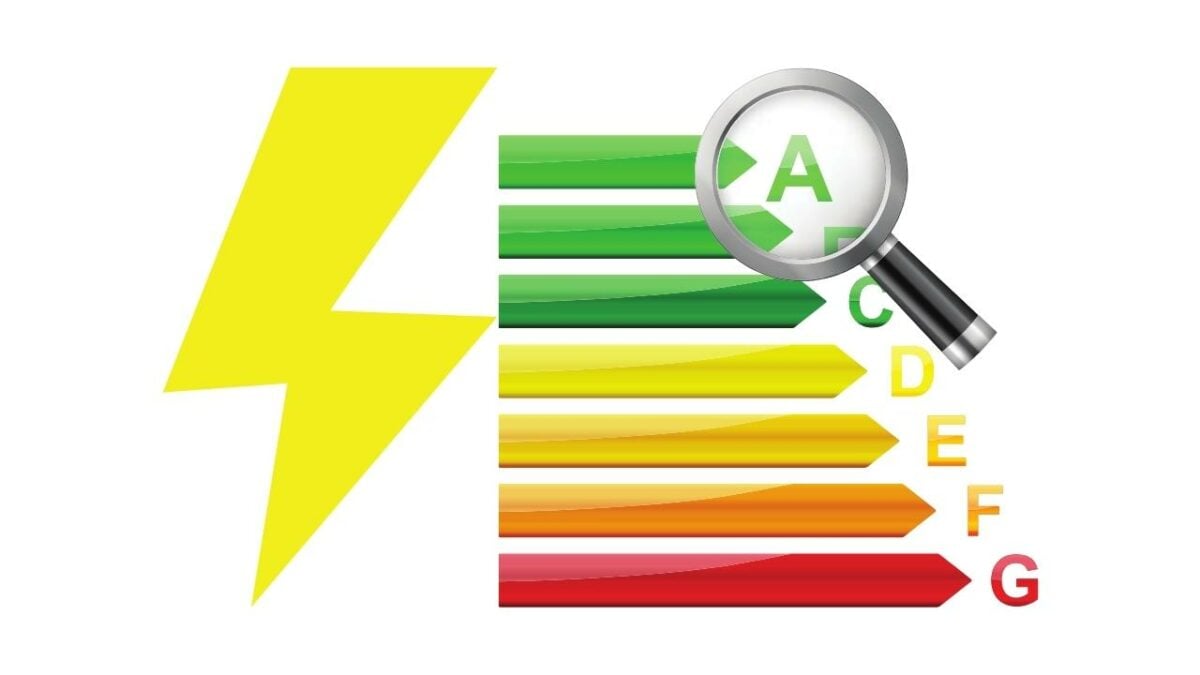
Hey, fellow fishkeeper! I’ve become a massive fan of Fluval products in the time I’ve been fishkeeping, so when I was looking to purchase a new filter for (yet another) tank I was setting up, it was no surprise I went with the Fluval 07 series.
In this article, we’ll dive into an in-depth comparison of these two models, highlighting their key differences to help you decide which is the right one for your home aquarium.
Having owned both of these filters, I will share with you my thoughts, and experiences and include some handy setup and maintenance tips.
Which 07 canister filter is right for you will depend on a few factors:
- Tank size
- Type of fish you have
- Do you have an overstocked aquarium?
Fluval 307 vs 407: What’s The Difference?
An in-depth comparison isn’t for everyone, so for those of you who want the quick version, here’s an overview of what each filter offers.
You may notice my tank size suitability figures differ slightly from what Fluval state, I’ve done a chart further down explaining how I work this out.
| FLUVAL 307 | FLUVAL 407 | |
| Tank Size | Up to 60 Gallons (227 Liters) | Up to 75 Gallons (284 Litres) |
| Pump Output | 303 g/ph (1,150 l/ph) | 383 g/ph (1,450 l/ph) |
| Filter Media Capacity | 3 baskets holding 0.8 gallons (3.1 liters) | 4 baskets holding 1.1 gallons (4.2 liters) |
| Power Consumption | 120V – 16 Watts / 230-240V – 15 Watts | 120V – 23 Watts / 230-240V – 20 Watts |
| Annual Running Cost (Approx) | $21.04 | $30.24 |
| Dimensions | H 16.5” x L 9.5” x W 7” | H 19.3” x L 9.5” x W 7” |
| Filter Media Included | 2 x Bio-Foam Max pads, 2 x Bio-Foam pads, 2 x Bio-Foam + pads, 2 x bags carbon, 2 x bags BioMax rings, and 2 x Quick Clear pads | 2 x Bio-Foam Max pads, 2 x Bio-Foam pads, 2 x Bio-Foam + pads, 4 x bags carbon, 2 x bags BioMax rings, and 2 x Quick Clear pads |
Both filters are a breeze to set up and maintain (details, video, and tips on how to do this further down).

So, the main things to consider when deciding which filter suits your needs the best are:
- Tank size: The Fluval 307 canister filter is suited for tanks up to 60 gallons (227 liters), while the Fluval 407 is best suited for tanks up to 75 gallons (284 liters).
- Size: The Fluval 407 is 2.8” / 7cm taller than the 307, so if you’re tight on space you may struggle to fit it beneath an aquarium.
- Filtration capacity: The Fluval 407 offers a higher filtration capacity with a circulation rate of 383 gallons per hour compared to the 307’s 303 gallons per hour.
- Energy efficiency: The Fluval 307 is the more energy-efficient option that can potentially save you money on your bills in the long run.
Based on a cost of $0.15 per kWh, the runnings costs for each filter are:
Fluval 307 = $21.04 per year.
Fluval 407 = $30.24 per year. - Tank Stocking Levels: If you have a heavily stocked tank, it’s best to choose a more powerful filter to keep the water clean and clear. Use the chart below to work out what flow rate you need for your setup.
4.6 | 4.6 |
Suitable for aquariums up to 60 gallons (227 liters). | Suitable for aquariums up to 75 gallons (284 liters). |
$189.99 | $229.99 |
Suitable for aquariums up to 60 gallons (227 liters).
Suitable for aquariums up to 75 gallons (284 liters).
What Size Canister Filter Do I Need?
A general rule of thumb is that you want the pump output (gallons per hour) to be 5 times the size of your tank, so multiply the size of your tank by 5 to find out the g/ph that is ideal.
I’ve found that following this simple calculation stops you from buying a filter that is too small or too large (and wasting money) for your aquarium.
If you have an overstocked stocked tank that has a large bioload, it’s recommended that you multiply your tank size in gallons by 10, to find a suitable turnover rate for your tank.
Since there is no standardized calculation used by all the different manufacturers, each manufacturer may suggest a different tank size suitability for their ‘XXX g/ph’ filter.
By using this formula, you can compare filters from different manufacturers on an equal basis.
| TANK SIZE (GALLONS) | NORMAL STOCKING LEVELS | HEAVILY STOCKED TANK |
| 20 | 100 g/ph | 200 g/ph |
| 29 | 145 g/ph | 290 g/ph |
| 40 | 200 g/ph | 400 g/ph |
| 55 | 275 g/ph | 550 g/ph |
| 75 | 375 g/ph | 750 g/ph |
| 90 | 450 g/ph | 900 g/ph |
| 100 | 500 g/ph | 1000 g/ph |
Most manufacturers state the g/ph when the filter is empty with no media in place.
Once the media is in place (and it’s got gunked up after a while!), these g/ph figures reduce drastically and the real-world turnover rate will probably be around 50% less.
Nonetheless, I’ve found on the whole that the filtration based on this calculation is more than adequate.
Fluval 307 and 407: Detailed Comparison
Now for those of you who like to know every last detail, grab yourself a cup of coffee and get comfortable, we dive into all the differences and go over some handy setup and maintenance tips.
Tank Size
The Fluval 307 is suitable for aquariums of up to 60 gallons (227 liters).
The Fluval 407 is suitable for aquariums of up to 75 gallons (284 liters).
The 07 series also has 2 smaller filters available, the Fluval 107 and 207 that are ideal for smaller tank sizes.
Type Of Fish You Keep
Different fish require different levels of filtration. Some fish are particularly messy so you need to make sure your filter can cope with them.
I’ll list a few common messy fish so if you keep any of these guys you may be best choosing the 407 because it has an additional basket for filter media to help catch the additional mess, to keep your water clean, clear, and smelling fresh!
Bristlenosed Pleco – Although these guys are part of a tank’s clean-up crew and do a great job of eating algae and leftover food, all that algae and food have to come out the other end!
Cichlids – In particular large cichlids like Oscars, who are known to rip up plants, stir up the substrate, and even re-arrange rocks, all creating lots of mess.
Goldfish – These guys love to dig around and stir up the substrate and are known for pooping a lot, so you need a filter that can cope.
Turtle – If you keep a turtle rather than fish in your aquarium, you will need a much more powerful filter to deal with the amount of waste they produce, check out my turtle filter guide for more info.
Freshwater and Saltwater Compatibility
Both the Fluval 307 and 407 external canister filters are designed to work in freshwater and saltwater aquariums.
Filter Media Included

Both filters come with the same types of filter media, consisting of mechanical, biological, and chemical filtration.
You get plenty of media included in the box, the only difference is you get 2 additional bags of carbon with the 407.
The Fluval 407 canister filter has a larger capacity because it has 1 additional internal basket, which can be useful if you have messy fish or a heavily stocked aquarium.
Mechanical Filtration Media
Mechanical filtration catches all of the debris in the water, if you’ve got loads of stuff floating around in the water, it’s time to rinse out those filter pads!
The Bio-foam Max, Bio-foam, Quick-clear, and Bio-foam + pads do a great job of catching all the nasty stuff.
Biological Filtration Media
Biological filtration uses beneficial bacteria to consume highly toxic ammonia and nitrites, turning it into safer nitrate, which you then reduce with water changes and by having live plants.
Beneficial bacteria grow on all surfaces in your aquarium, so the more surface area you can provide the better, having the additional basket in the 407 really helps here, especially in a heavily stocked aquarium.
Bio-max rings provide valuable extra surface area for beneficial bacteria to colonize, aiding in breaking down these harmful toxins, and keeping your nitrogen cycle in check, helping keep the water safe for your fish.
Chemical Filtration Media
Activated carbon helps remove chemical impurities, odors, and discoloration from the water, keeping it crystal clear and smelling sweet, no one wants their tank to smell like rotten eggs!
Activated carbon needs to be replaced regularly as it will stop working, aim to replace it after a month.
Important: Carbon also removes medications, so remove all activated carbon filter media when treating your fish with medication.
Fluval 307 And 407 Setup and Installation
Setting up both of these 07 series canister filters is the same process, I’ll also include a video as I find it’s easier to watch a video before reading an explanation, to help everything make more sense.
Setup
One thing I really like about the Fluval 07 series filters is that setting them up is a breeze.
One thing to note is it’s important to put your canister filter media in the correct baskets (see image below).
You want the water to pass through the mechanical filtration first (coarse first, then finer media), then through the biological filtration, and finally through the optional chemical filtration.

Although they arrive assembled, you have to take it all apart as there’s a leaflet inside the canister, the filter media comes sealed in plastic bags, as does the rubber gasket seal that goes between the canister and lid.
The ceramic rings can get a bit dusty during shipping, so make sure you rinse them thoroughly to get all of the dust off them.
If you have a heavily planted tank, you may want to avoid using activated carbon as it will filter out the nutrients in the water that your plants thrive off, it will also soak up any plant fertilizer you add. If you find your plants starting to look unhealthy, this could be the culprit.
You could fill the top media basket (or baskets if you choose the 407) with some extra ceramic rings instead, giving plenty of additional surface area for beneficial bacteria to grow.
Putting it back together is the exact reverse of taking it apart.
Inside the canister are tracks molded into the sides to form different compartments. The filter media baskets and frame that hold the Bio-foam and Bio-foam Max pads will only fit back inside one way.
TOP TIP: When you’ve put the Bio-foam+ and quick clear pads back in the bottom tray put the red lifting handle through the basket at this point.
It’s much easier to then stack the rest of the baskets on top of each other with the handle in place rather than inserting the handle once you’ve stacked the baskets on top of each other….Yes, I learned the hard way!
Install the rubber gasket on the filter lid.
Like the baskets, the canister lid will only fit one way too. The 307 or 407 badge on the front of the lid fits into a notch molded into the rim of the canister body.
The hose clamps do a great job of keeping the intake and output hoses in place and are a much better design than those on the FX4 and FX6 filters.
When it comes to fitting the hose clamps to your tank, all I’ll say is: read the instructions first (or watch the YT video above)…I’m a typical guy, instruction manuals must not be read at all costs, I will struggle and tear my hair out first!!
Basically, the fittings have 2 parts: the clamp that fits onto the tank and the cover that secures the piping in place.
The covers need to be fitted vertically. The rear part of the clamp and the pipe cover slide together using tongue and groove moldings. The underside of the curved part of the cover then clips onto the curved part of the clamp.
AquaStop Valve

The Aquastop valve is a key feature of the 07 canister filter range.
This valve allows you to stop the water flow and then detach it from the filter in one piece, making cleaning and maintenance waaaaaaaay easier.
To install the Aquastop valve:
- Place the Aqua stop valve on the inlet and outlet ports on the top of your canister filter and press the red lever down to lock it in position.
- Lift the grey lever up so it’s vertical to put the valve in the OFF position.
Placement
Place the filter on a flat and sturdy surface, beneath your fish tank.
Canister filters are ‘gravity fed’ so they need to be below the tank for them to work correctly. If you put a canister filter at the side of a tank, the top of the filter must be below the surface of the water, but it can be tricky to get the filter working efficiently.
Position the filter as close to your aquarium as you can and avoid any sharp bends or turns in the tubing.
Fit The Tubing
The intake and output hose is supplied in a single length that you have to cut yourself.
To avoid miscutting my pipe the wrong length (come on, we’ve all done it!) I find it easier to attach both ends of the pipe to the filter valves at this point, then cut it once I know it will reach over the top of the tank and back into the water.
If you do miscut the tubing, it’s not the end of the world, you can get a replacement length of Fluval ribbed hosing.
Regardless of which filter you pick, the included hardware is the same. The intake assembly is 13.75” (35cm) in length so you’ll need to account for that when trimming the intake pipe.
The Aquastop valve is clearly marked which side is the intake and outlet so you can’t get this wrong.
The output nozzle does a decent job itself, but you can add the Fluval Spray Bar Kit, to help eliminate surface scum and aerate the water.
Priming
To prime the pump:
- Ensure your output nozzle is above the water’s surface so it has access to air.
- Press the grey lever on the Aquastop valve downwards so it sits on top of the red lever.
- Move the priming handle up and down 3 or 4 times until you can hear the filter filling itself with water.
Once the canister filter has filled with water, plug it into the mains power and you should have water flowing out of the outlet nozzle.
I always recommend having an aquarium drip loop on all electrical items, we all know water and electricity are not a good match!

That’s it, you’re all set up and good to go.
Maintenance and Cleaning
It is the same process for cleaning both the Fluval 307 and 407 filters.
The only thing missing from the Fluval filters is a handle like the Oase Biomaster filters have, a simple thing that makes life easier….but it’s not a deal breaker!
Never use soaps or detergents to clean your filter (or aquarium).
- Disconnect the filter from the aquarium and unplug: Lift the grey lever on the Aquastop valve so it’s vertical, this puts it into the off position and stops the flow of water. Unplug from mains power. Lift the red lever to disconnect the Aquastop valve from the filter.
- Put a towel and bucket on the floor and empty the water from the filter into the bucket, you’ll then use this water to clean everything.
- Remove the filter lid by pulling the grey lift-lock motor head clamps outwards and then push down on them until the lid releases.
- The EZ-Lift media baskets can be removed with one finger using the red handle.
Clean the mechanical filter media: Gently squeeze the sponge or foam media in the bucket to remove larger debris and waste particles, you don’t need to get them spotless.
Inspect and rinse the biological media: Check the ceramic rings or bio-balls for any accumulated debris and gently swish them in the same bucket to remove surface dirt.
Replace the chemical filter media as needed: Chemical media has a limited lifespan and should be replaced according to the manufacturer’s recommendations or when you notice a decline in water quality.
Top Tip: Use the water in the bucket that you rinsed all the filter media in to water your house plants or garden, your plants will love it! - Clean the filter’s impeller and housing: Over time, debris and slime can accumulate in this area, resulting in reduced pump performance.
The impeller is located under the red cover on the underside of the lid. Remove the impeller and gently clean it in the bucket and wipe out the housing where the impeller sits with a cloth. - Clean the main body of the canister where the filters go: Add a bit of water and swish it around to loosen any brown sludge in the bottom and pour it into the bucket.
- Finally, using a bottle brush clean the input and output nozzles to remove any buildup or debris. These nozzles pull apart easily so you can get into all the nooks and crannies.
- Reassemble and reconnect the filter: Once everything has been cleaned, reassemble the media baskets, fit the lid, and reconnect the pipes by pulling down the red lever and then the grey lever, you will hear a flow of water as your filter re-fills (if you don’t hear water flowing, pump the primer a few times).
- Once your filter has filled up plug it back into the mains power.
Top Tip: When you put the lid back on, push it down firmly all the way around before clipping the grey brackets in place, this ensures you have a nice tight water seal and avoids any leaks.
You will need to lubricate the rubber o-ring occasionally using a silicone-based lubricant.
Pump Performance and Efficiency
When you’re looking to choose a new canister filter, the filter’s pump performance and energy consumption are important things to consider with the ever-increasing cost of living.
Pump Output and Circulation
The Fluval 307 flow rate is 303 Gal/h (1,150 L/ph), making it suitable for aquariums of up to 60 gallons.
The Fluval 407 flow rate is higher, coming in at 383 Gal/h (1,450 L/ph), making it suitable for aquariums of up to 75 gallons, or for a heavily stocked smaller aquarium.
Energy Efficiency

With ever-rising energy prices, this has to be something to take into consideration.
Both Fluval 307 and 407 filters excel in energy efficiency, consuming 25% less power compared to their predecessors (the Fluval 06 canister filters) while still providing great performance.
The 307’s power consumption is 120V – 16 Watts / 230-240V – 15 Watts.
The 407’s power consumption: 120V – 23 Watts / 230-240V – 20 Watts.
The approximate annual running cost of each filter is:
- Fluval 307, based on $0.15 per kWh = $21.04 per year
- Fluval 407, based on $0.15 per kWh = $30.24 per year
Filter Noise
In terms of noise, both are quiet when running. I’m really sensitive to background noises, the slightest little thing drives me nuts if I’m trying to read or watch TV.
When I tested my 407, it came in at 48 decibels (right next to it) using the noise app on my Apple Watch.
Price
The 307 is the smaller of the 2 filters so is a little more budget-friendly.
4.6 | 4.6 |
Suitable for aquariums up to 60 gallons (227 liters). | Suitable for aquariums up to 75 gallons (284 liters). |
$189.99 | $229.99 |
Suitable for aquariums up to 60 gallons (227 liters).
Suitable for aquariums up to 75 gallons (284 liters).
Conclusion – Which Canister Filter Is Right For You & Your Aquarium?
I’m super happy with my 07 series filters and can highly recommend them, they’re reliable, quiet, and cheap to run, so which should you buy?
If you have an aquarium of up to 60 gallons, buy the 307.
If you have an aquarium that 60-75 gallons, buy the 407.
If you need stronger filtration due to having a heavily stocked or larger tank, the Fluval FX2 may be more suitable.
Check out the equipment section for more comparisons and setup guides like this one, and the aquarium health section for guides on keeping your finned friends happy and healthy.




